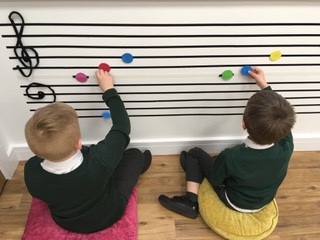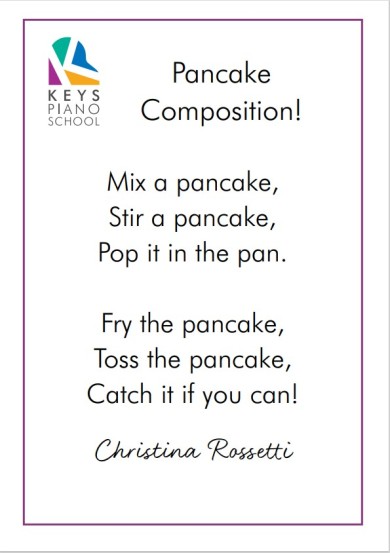Teacher, writer and composer Jeni Warder has penned my latest guest article. Jeni, who owns and runs the Keys Piano School in Bolton, UK, is writing a regular column on this blog, and she is focusing on teaching composition to young students. You can read Jeni’s previous posts here and here.
In this article, she encourages teachers to experiment with various teaching tools in order for students to create their own little piano pieces, which can be submitted as part of a Trinity College London piano exam. Over to Jeni…
Recently I was given the valuable opportunity to share some of the many reasons for including composition as a core part of our curriculum at Keys Piano School, my home studio in Bolton. We are very much a grassroots organisation, with children from a huge variety of backgrounds. However, by encouraging students to create music which reflects themselves and their own experience, we aspire to raise a generation of young musicians who see their music as a part of themselves and understand that over time they can develop their own style and voice.
While we can agree that composition is clearly valuable and empowering for learners, it can be difficult to know how to ‘package’ this kind of teaching when working with very inexperienced students. Over the past few years, I’ve worked through this process many times, with wide-ranging results and I’d like to share a selection of teaching sequences, which seem to both further a student’s learning, while producing good compositional outcomes. In this article I will focus on producing a very simple piece, which would be suitable for Trinity Initial grade if required.

Composing with very young children at this level obviously raises some issues of independence. If children are to truly be free to compose their own work, I feel that they should be in ultimate control of their finished product, and I, as the teacher, must only provide guidance. However, children need to be supported in understanding how music can be developed, and therefore lots of preliminary work is useful so that they can see the process of putting a piece together. In this sequence I therefore suggest four activities, which I typically use over 3-4 lessons alongside other work. The first three suggestions are improvisation and exploration and can used as a “warm up” to the project. Following this, the final activity is to use their learning to develop ideas into a new composition.
Previous learning
At initial level, students are expected to be familiar with the keys of C major and A minor, including playing the scales and broken triads of each as part of the technical requirements for the exam. At Keys we also require children to understand the connection between these two related keys (which I sometimes describe as “the same team with different captains”). It’s a good idea for this to have been discussed prior to beginning these lessons, although the activities will certainly help to consolidate this understanding.
Activity 1: Questions and Answers
The first stage is to create a two-bar phrase in 4/4 time. This is a great little activity even for the youngest children and earliest beginners. It works on black notes for young starters, but at this level it’s easiest to do by assigning a note from C-G (fingers 1-5) to each of seven crotchets, the final beat being taken by a rest at the end of the phrase. After a few attempts using different notes, children establish that finishing on C makes the phrase feel finished, whereas finishing on any other note it feels unfinished – because C is ‘home’, or ‘The Boss!’ as we call it! Taking two of these phrases, we can then play a ‘question and answer’ game across the room – I ‘ask a question’ using a phrase that sounds unfinished, and they ‘answer’ with a finished phrase on C. After going backwards and forwards with this, exploring what they like and don’t like, they decide on their own ‘question and answer’ phrases.

Some discussion usually follows on what made the best phrases. They can usually hear that those which jump around using bigger intervals sound less appealing than those which mostly use seconds and thirds. It’s also interesting for them to hear how using repetition (for example starting both phrases in the same way) is also pleasing to our ears.
Activity 2: Intervals as accompaniment
Once we’ve established a melody, it’s important to explore how harmony can be used to give our ideas more character and depth. The sheet provided is in itself an activity on interval recognition and note naming and can be used at any time as such. However, used with the first activity above, this can also act as a kind of ‘menu’ of ideas from which to choose accompanying chords. I do also find it can be appropriate to show children how we need to choose carefully, and that next-door notes such as E in the melody over F in the chord will not work well together for a long period of time. It may also be useful to talk about passing notes and how we can generally trust our ears to tell us when something is more or less harmonious! By the end of this stage, children have a 4-bar theme with accompaniment, which is just enough to feel like a mini-piece.

Activity 3: Structure and transposition to the relative minor
Once children are secure in their own phrases with left hand accompaniment, they find it fascinating to transpose their ideas into the relative minor! Within the context of C and Am this is clearly very straightforward, and they can usually adapt immediately to this new key. This is a great opportunity to consolidate the understanding of relative keys and the concept of “same team, different captain” as I mentioned earlier. Asking children to change another element in this minor version is also great for developing the character of a new section. Could we play the minor version staccato? Or more piano? Or should we try it low and grumpy, or high and twinkly? When they have two clear sections established, they can choose how to finish their piece. Most choose a return to the original major key, but often with some changes in style or register. Some prefer to end in the minor and leave it there!

Activity 4: Setting up the independent composition
Now the children have explored phrases, harmony, transposition and structure during the activities above, they need to start a project that is less structured and more their own work. It’s still important to give a stimulus, however, and I find at this level that poems work really well, especially if it’s based on a subject which takes their interest. In most cases, you can rely on anything about food to grab their attention, so for the initial grade children’s pieces by Max and Ava (shared on the YouTube link below), I used ‘Pancake Poem’ by Christina Rossetti. It’s very accessible for children and is written in clear phrases. We began by clapping the rhythm of the poem as we heard it, including a dotted rhythm which we notated together. This created an overall rhythmic structure to work within, making them feel more secure. The use of a poem also helps children give their work an identity – it became a story-telling process for some, and you can hear the final ‘splat’ as the pancake hits the floor in Max’s piece!

You can see the final videos from two of the children in this group on the YouTube link below, along with other pieces at different levels.
If you found any of these activities useful, or you have other ideas which we could try out, please let us know!
Jeni Warder is the founder and Creative Director of Keys Piano School in Bolton, Greater Manchester. Keys is a Champion Centre for Trinity College examination board, and also released an album of student/teacher collaboration works entitled “The Seasons Reinvented” in 2021.

My publications:
For much more information about how to practice piano repertoire, take a look at my piano course, Play it again: PIANO (published by Schott Music). Covering a huge array of styles and genres, the course features a large collection of progressive, graded piano repertoire from approximately Grade 1 to advanced diploma level, with copious practice tips for every piece. A convenient and beneficial course for students of any age, with or without a teacher, and it can also be used alongside piano examination syllabuses too.
You can find out more about my other piano publications and compositions here.
from Melanie Spanswick https://melaniespanswick.com/2022/03/27/teaching-through-composition-thinking-in-phrases-at-initial-level-jeni-warder/
No comments:
Post a Comment